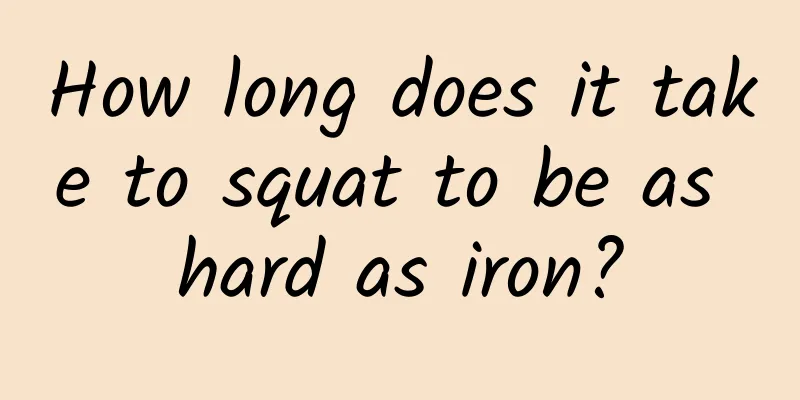How long does it take to squat to be as hard as iron?

|
Weighted squats are a difficult exercise. They can really enlarge muscles, effectively increase body energy, and consume body fat. They are very popular and loved by everyone. The squatting posture must be done correctly. If you want to know how long you need to squat with weights to become as hard as iron, you must master the posture standard of weighted squats. Let's learn it in practice. 1. Standard posture for weighted squats One of the reasons why weighted squats are controversial is that incorrect postures not only fail to achieve the actual training effect, but can also damage muscle groups, especially the knee joints. Therefore, mastering the standard squat posture is crucial. Stand up, hold your head high, keep your upper body straight, and be able to extend forward slightly; separate your feet to the width of your shoulders, do not bend your waist, keep your feet parallel, and your heels facing forward; your feet can also be separated at a certain angle, about 60 degrees, but keep the position of your knee joints and heels consistent when squatting. Squat down gradually until the angle between your thighs and calves is more than 90 degrees, but do not press tightly to release pressure, about 70-80 degrees is enough; then stand up with force in front of the thigh root until you stand up straight. When squatting, the knees should not exceed the heels as much as possible; keep the knees forward from beginning to end, in the same position as the heels, do not turn inward, and do not shake; when exerting force, purposefully let the buttocks exert force first; maintain a constant speed throughout the whole process, and the speed should not be too fast. 2. Common problems with squats 1. When doing high-leg exercises, if the speed is too fast, the frequency is too high, or if you use explosive force and rebound force, you will hurt your kneecap. Some people often combine high-leg exercises with jogging, which is the most harmful to the knee joint. 2. Bend your legs and squat down, keeping your eyes on the ceiling. This is to ensure that your body continues to be vertically lowered throughout the squatting process, and it is not easy to have an incorrect posture of lowering your head and sticking out your butt. 3. When squatting, the position of the knee should be consistent with the position of the heel. It should not be turned inward or shaken. This point should be paid attention to. Only in this way can the knee conform to sports physiology. You must pay attention to this point no matter what posture you do in the future. If the position of the knee is not consistent with the position of the heel, the knee will be damaged. 4. When standing up, you should still be able to see the ceiling with your eyes, and your spine should be very straight, so that your body can stand up vertically. In other words, keep your legs straight and use the power of your legs to lift your body up. You must not use the method of lowering your head and sticking your butt out to straighten your legs. In this way, the body can stand up vertically, and the range of flexion, extension and contraction of the thigh muscles is larger, and the actual training effect is the best. 5. When doing high leg raises, you should reduce the frequency and slow down the speed, and maintain a constant speed throughout the whole process. The speed should not be too fast. Generally, 10-15 sets, 2-3 sets are enough. 6. Jogging must be separated from high-leg raising, and don't jog for a long time. Don't do variable-speed running. It's best to run for 20-30 minutes. 7. Raising your legs high can speed up blood circulation. Dizziness when you stand up quickly is caused by insufficient blood supply, which is normal. 8. Cardiovascular and cerebrovascular patients are not suitable for high leg raising exercises as they may suffer from momentary insufficient blood supply to the brain. 9. Keep your upper body straight and slightly lean forward, but do not bend your waist. 10. When squatting, your knees should not extend beyond your heels as much as possible. 11. When exerting force, you should purposefully use your buttocks first. |
>>: Men have sexually transmitted diseases pictures
Recommend
There is a red spot on the glans penis, no pain or itching
Symptoms related to the male genitals or the glan...
Pain in the inner right thigh of a man
The inner thigh root of a man is a very private a...
Do not smoke within half an hour of taking the medicine
Smoking is a health killer, and many people are a...
How to treat low sperm survival rate?
In real life, low sperm survival rate is a common...
What should I do if I have leg cramps? What are some ways to prevent leg cramps?
Leg cramps are a very common phenomenon in life. ...
Precautions for orchiectomy
The testicle is one of the more important reprodu...
How to treat obesity? Eat like this to keep obesity away
Many men are always willing to say that they are ...
What to do if a boy has genital pain
Most boys are too embarrassed to talk about genit...
What medicine is good for men who sweat a lot?
Sweating is a very common phenomenon in normal ti...
Almond weight loss, eating almonds can help you lose weight quickly
Almonds are a nutritious nut. Many people think t...
How many days after circumcision is it best to remove the stitches?
Many men have experienced the trouble of having t...
How does premature ejaculation occur?
With the openness of today's young people'...
What's going on when the amount of ejaculation decreases?
For men, the most embarrassing thing is problems ...
What are the treatments for scrotal hernia?
I once read a science fiction novel that said tha...
If the urethra is inflamed, the frenulum and foreskin will swell.
If the male urethra is inflamed, the external ope...









